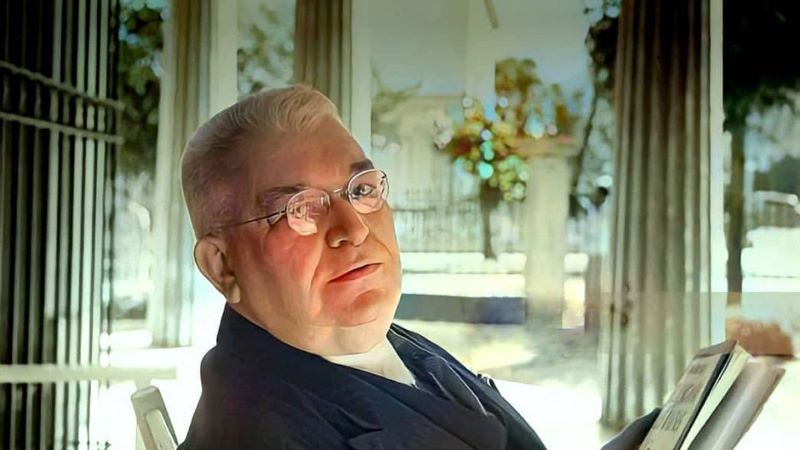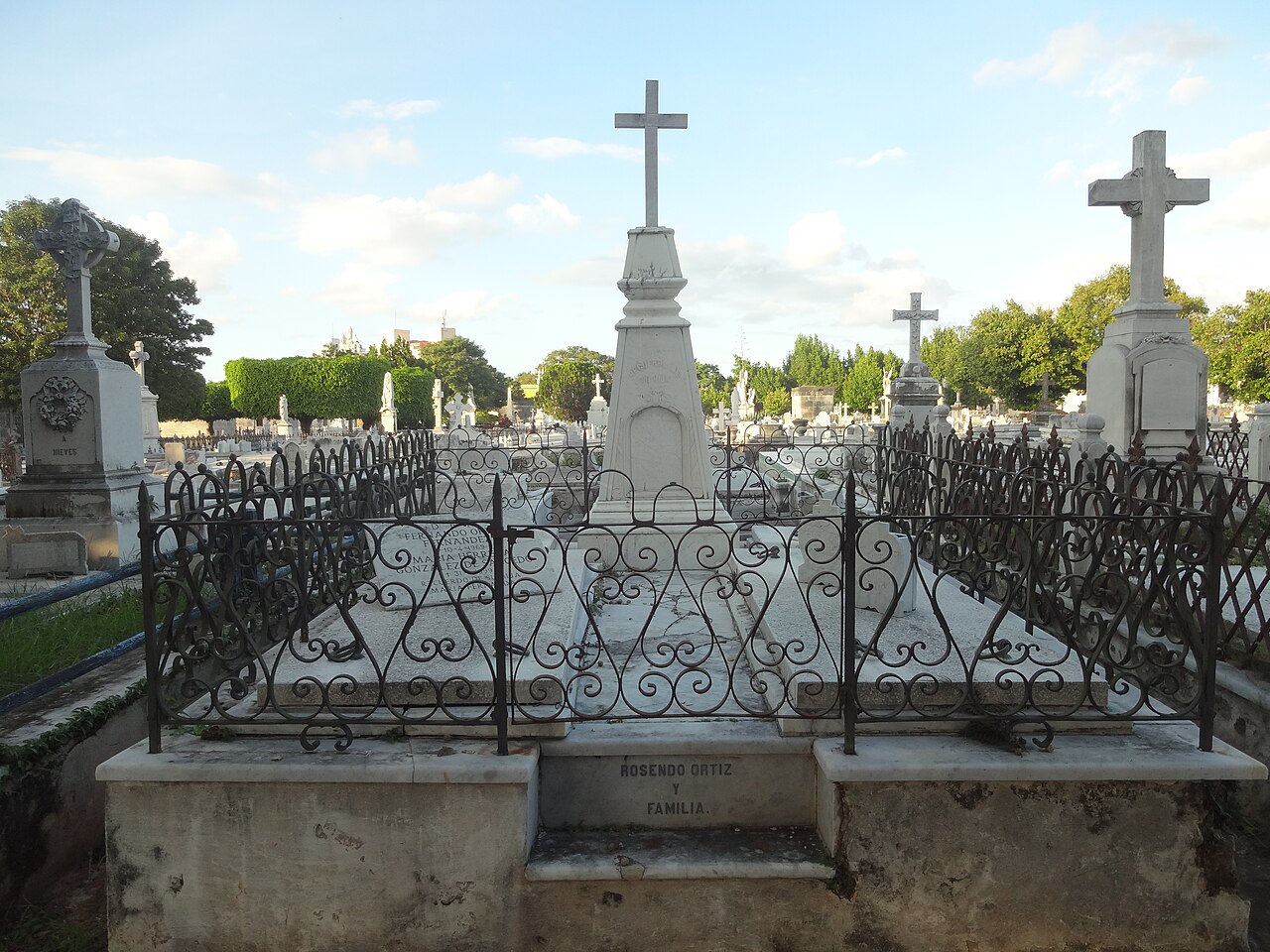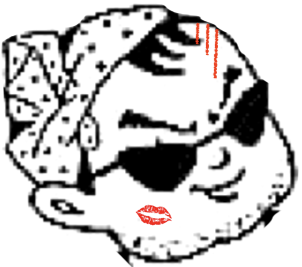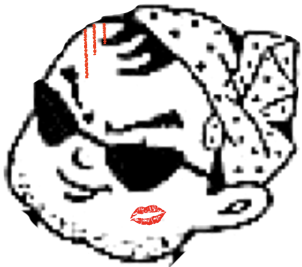
フェルナンド・オルティス・フェルナンデス
Fernando Ortiz Fernández, 1881-1969

☆ フェルナンド・オルティス・フェルナンデス(1881年7月16日 - 1969年4月10日)は、キューバのエッセイスト、人類学者、民族音楽学者、アフリカ系キューバ文化研究家である。オルティスは、キューバの土着文化の あらゆる側面を探求し、記録し、理解することに専心した多才な博識家であった。オルティスは、クリストファー・コロンブスとアレクサンダー・フォン・フン ボルトに次いで「キューバの第三の発見者」と呼ばれている。この称号は、彼の秘書であったルベン・マルティネス・ビレナによって初めて与えられ[1]、後 にフアン・マリネロによって繰り返し、出版された。[2] オルティスは、ポストコロニアルのラテンアメリカ思想における先駆者、およびアフリカ系アメリカ人の人類学における基礎的な声として広く認められている。 [2][3] オルティスの最も影響力のある貢献のひとつは、「トランスカルチュレーション」という用語を考案したことである。これは、文化の収束と交流の複雑なプロセスを説明するものである。[4]
| Fernando Ortiz Fernández
(16 July 1881 – 10 April 1969) was a Cuban essayist, anthropologist,
ethnomusicologist and scholar of Afro-Cuban culture. Ortiz was a
prolific polymath dedicated to exploring, recording, and understanding
all aspects of indigenous Cuban culture.Ortiz has been called the
"third discoverer of Cuba", after Christopher Columbus and Alexander
von Humboldt. A title first given to him by his secretary Rubén
Martínez Villena[1] and later echoed and published by Juan
Marinello.[2] Ortiz is widely recognized as a pioneering figure in
postcolonial Latin American thought, as well as a foundational voice in
African American anthropology.[2][3] One of Ortiz's most influential
contributions is his coining of the term "transculturation," which
describes the complex process of cultural convergence and exchange.[4] |
フェ
ルナンド・オルティス・フェルナンデス(1881年7月16日 -
1969年4月10日)は、キューバのエッセイスト、人類学者、民族音楽学者、アフリカ系キューバ文化研究家である。オルティスは、キューバの土着文化の
あらゆる側面を探求し、記録し、理解することに専心した多才な博識家であった。オルティスは、クリストファー・コロンブスとアレクサンダー・フォン・フン
ボルトに次いで「キューバの第三の発見者」と呼ばれている。この称号は、彼の秘書であったルベン・マルティネス・ビレナによって初めて与えられ[1]、後
にフアン・マリネロによって繰り返し、出版された。[2]
オルティスは、ポストコロニアルのラテンアメリカ思想における先駆者、およびアフリカ系アメリカ人の人類学における基礎的な声として広く認められている。
[2][3] オルティスの最も影響力のある貢献のひとつは、「トランスカルチュレーション」という用語を考案したことである。これは、文化の収束と交流の複雑なプロセスを説明するものである。[4] |
| Early life and education Ortiz was born in Havana. He was son of Don Rosendo Ortiz y Zorrilla and Doña Josefa Fernández y González del Real.[5] When he was two years old he moved with her mother to Menorca where he spent most of his youth. He also completed his primary and secondary studies and obtained his high school diploma in 1895.[5] That year, he relocated to Havana where he began studying law. Four years later, in 1899, he returned to Spain, this time to Barcelona, where he completed his studies and earned a law degree at the University of Barcelona in 1900.[5] In 1901 he received his title of Doctor of Law at the Central University of Madrid with a thesis on penal law that was later published in the journal Derecho y Sociología. [5][6] In 1902 he returned to Habana and received the title of Doctor of Civil Law and Doctor of Public Law.[6] |
幼少期と教育 オルティスはハバナで生まれた。彼はドン・ロセンド・オルティス・イ・ソリージャとドニャ・ホセファ・フェルナンデス・イ・ゴンサレス・デル・レアルの息子であった。 2歳の時に母親と共にメノルカ島に移り、そこで青年期の大半を過ごした。また、初等・中等教育を修了し、1895年に高校卒業資格を取得した。その年、ハ バナに移り、法律の勉強を始めた。4年後の1899年、彼はスペインに戻り、今度はバルセロナで学業を修了し、1900年にバルセロナ大学で法学の学位を 取得した。[5] 1901年には、刑法に関する論文でマドリード中央大学の法学博士号を取得し、その論文は後に『Derecho y Sociología』誌に掲載された。[5][6] 1902年に彼はハバナに戻り、民法博士および公法博士の称号を受けた。[6] |
| Career Disillusioned with politics in the early period of Cuban history and having been a member of President Gerardo Machado's Liberal Party, and a Liberal member of its House of Representatives from 1917 to 1922, he became active in the early nationalist civic revival movement. Throughout his life Ortiz was involved in the foundation of institutions dedicated to the study of Cuban culture. In 1907 he became member of Sociedad Económica de Amigos del País de Cuba (Economic Societies of Friends of the Country), the he eventually led in 1923.[7] He was the cofounder of the Cuban Academy of the Language in 1926 and the cofounder of the Sociedad de Folklore Cubano (1928).[6] In 1937 he founded the Sociedad de Estudios Afrocubanos (Society of Afro-Cuban Studies) and the journal Estudios Afrocubanos (Afro-Cuban Studies). He was president of the History Academia of Cuba and the Cuban-Soviet Institute (1945).[5] He was also the founder and director of the Instituto Internacional de Estudios Afroamericanos (International Institute for the Study of Afroamericans),[8] an institute dedicated to promoting scientific research on Afro-descended populations in the Americas, focusing on their biological and cultural aspects.[9] The institute organized conferences, conducted studies, and served as a hub for the dissemination of research and collaboration among scholars and institutions.[9] He later invited American anthropologist and sociologist W.E.B. Du Bois[10] to join the institute, along with other renowned anthropologists like Melville Herskovits.[8] Ortiz also dedicated a significant part of his life to founding, editing, and contributing to academic journals. He resumed the publication of Revista Bimestre Cubana in 1910, serving as its director until 1959, the year the Cuban Revolution began.[7] He also edited Revista de administración teórica y práctica del Estado, la provincia y el municipio (1912) and Boletín de Legislación (1929).[5] In 1924, he founded Revista Archivos del Folklore Cubano.[7] Additionally, he was the founder and editor of Surco (1930–1931) and Ultra (1936–1947), both journals that provided commentary on international publications.[11] Ortiz was professor of African American anthropologist Irene Diggs when she was doing her PhD in anthropology at University of Havana.[12] Ortiz published articles in several prominent journals, including The Hispanic American Historical Review, Revista Científica Internacional, Revista de Administración, Revista de Arqueología y Etnología, and Revista de La Habana.[13] He also helped establish important journals such as Revista Bimestre Cubana, Archivos del Folklore Cubano, and Estudios Afrocubanos.[5][7] Ortiz also developed a theory of activism within Cuba's political system. He said that Afro-Cubans had been characterized negatively based on their African descent, and traits said to be "primitive." He wanted to show the true nature of their culture: its language, music and other arts.[14] His books, La Africania de la Musica Folklorica de Cuba (1950), and Los Instrumentos de la Musica Afrocubana (1952 - 1955) are still regarded as key references in the study of Afro-Cuban music. In his second marriage, Fernando Ortiz married María Herrera (1942), who remained by his side for the rest of his life.[15] María was a close collaborator in Ortiz's work.  Ortíz's grave at the Cementerio de Cristóbal Colón in Havana, Cuba Fernando Ortiz died in Havana in 1969 and was interred there in the Colon Cemetery.[16] |
キャリア キューバの歴史の初期に政治に幻滅し、1917年から1922年まで、ヘラルド・マチャド大統領のリベラル党の党員および下院のリベラル派議員を務めた後、初期の民族主義市民復興運動に積極的に参加するようになった。 オルティスは生涯を通じて、キューバ文化の研究に専念する機関の設立に関わった。1907年には、1923年に自ら率いることになるソシエダ・エコノミ カ・デ・アミーゴス・デル・パイス・デ・クーバ(キューバ経済友愛会)の会員となった。[7] 1926年にはキューバ言語アカデミーの共同創設者となり、 1928年にはキューバ民俗学会の共同創設者となった。[6] 1937年には、アフリカ系キューバ人研究学会および学術誌『Estudios Afrocubanos』(アフリカ系キューバ人研究)を創設した。 1945年には、キューバ歴史アカデミーおよびキューバ・ソビエト研究所の会長を務めた。[5] また、アメリカ大陸のアフリカ系住民の生物学および文化的な側面に焦点を当てた科学的研究を推進する機関である、国際アフリカ系アメリカ人研究協会 (Instituto Internacional de Estudios Afroamericanos)の創設者および初代理事長でもあった。[8][9] この協会は会議を主催し、 研究を行い、学者や研究機関間の研究や協力の普及の拠点となった。[9] その後、アメリカ人類学者で社会学者のW.E.B. デュボイス[10]を研究所に招き、メルヴィル・ハースコヴィッツのような著名な人類学者たちとともに研究を行った。[8] オルティスは、学術誌の創刊、編集、寄稿にも人生の多くの時間を捧げた。1910年には『キューバ隔月刊誌』の発行を再開し、キューバ革命が始まった 1959年まで編集長を務めた。[7] また、『国家、州、自治体の理論的・実践的管理誌』(1912年)や『立法情報誌』(1929年)の編集も手がけた 。[5] 1924年には『Revista Archivos del Folklore Cubano』を創刊した。[7] さらに、国際的な出版物の論評を提供する雑誌『Surco』(1930年~1931年)と『Ultra』(1936年~1947年)の創刊者兼編集者でも あった。[11] オルティスは、キューバ大学で人類学の博士号を取得していたアフリカ系アメリカ人人類学者アイリーン・ディッグスの教授であった。 オルティスは『ヒスパニック・アメリカン・ヒストリカル・レビュー』、『レヴィスタ・シエンティフィカ・インテルナシオナル』、『レヴィスタ・デ・アドミ ニストラシオン』、『レヴィスタ・デ・アルケオロギア・イ・エトノロギア』、『レヴィスタ・デ・ラ・ハバナ』など、著名な学術誌に論文を発表した。 [13] また、『レヴィスタ・ビメストレ・クバーナ』、『アルキボス・デル・フォルクロレ・クバーノ』、『エストゥディオス・アフロクバーノス』などの重要な学術 誌の創刊にも貢献した。[5][7] オルティスは、キューバの政治体制における活動理論も展開した。彼は、アフリカ系キューバ人はアフリカに起源を持つという理由で否定的に特徴づけられてお り、その特徴は「原始的」であるとされていたと述べた。彼は、彼らの文化の真の姿、すなわち彼らの言語、音楽、その他の芸術を明らかにしたいと考えた。 彼の著書『キューバの民俗音楽におけるアフリカ性』(1950年)と『アフロキューバ音楽の楽器』(1952年~1955年)は、現在でもアフロキューバ音楽研究における重要な参考文献とされている。 2度目の結婚で、フェルナンド・オルティスはマリア・ヘレラ(1942年生まれ)と結婚し、彼女は生涯彼のそばに寄り添った。[15] マリアはオルティスの仕事の親しい協力者であった。  キューバ、ハバナのクリストバル・コロン墓地にあるオルティスの墓 フェルナンド・オルティスは1969年にハバナで死去し、コロン墓地に埋葬された。[16] |
| Cuban Counterpoints and the concept of Transculturation Fernando Ortiz most known and read book was Cuban Counterpoint: Tobacco and Sugar originally published in 1940 in Spanish and translated to English in 1995.[17] In his book he draws comparisons between sugar and tabaco the most relevant products form Cuba that have entered the daily life of cubans.[4] In this work, he proposes the concept of transculturation as a phenomenon that is more appropriate than acculturation to describe how cultures converge and merge, without removing some of the original aspects of the original cultures.[4] The concept provided a more appropriate way to explain the merging of cultures in Cuba, from Spanish colonialism to Indigenous communities and Afro-Cubans, resulting in a new culture that incorporates elements from each.[4] In the introduction of the book the renowned Polish anthropologist Bronisław Malinowski (1884-1942) wrote the introduction supporting Ortiz's concept [18] His correspondence with Bronisław Malinowski shows they had numerous debates around the concept of transculturation and how it was being received within American anthropology.[19] This led to disputes between Oritz and Melville Herskovits the American anthropologist that coined the term acculturation.[19] The concept of transculturation that Ortiz developed resonates with the principles of British functionalism, which Malinowski himself helped pioneer.[2] Malinowski was not only a personal friend but also an admirer of Ortiz's work.[20] The letters published between Malinowski and Ortiz as part of a 2002 edition of Cuban Counterpoints, by Enrico Mario Santí, show that Malinowski commented the structure of the book, proposed ideas and concepts that influenced the book.[20] |
キューバの対位法とトランスカルチュレーションの概念 フェルナンド・オルティスの最もよく知られ、読まれている著書は、1940年にスペイン語で出版され、1995年に英語に翻訳された『キューバの対位法: タバコと砂糖』である。[17] 著書の中で、彼はキューバの最も重要な産物である砂糖とタバコを比較し、それらがキューバ人の日常生活に入り込んでいることを示している。[4] この著作で、彼は、文化が収束し融合する過程を説明するのに、文化の原初的側面を排除することなく、文化変容よりも適切な現象として「文化横断」という概 念を提唱した。[4] この概念は、スペインの植民地主義から先住民のコミュニティやアフリカ系キューバ人へと至るキューバの文化の融合を説明するのに、より適切な方法を提供し た。 、その結果、それぞれの要素を取り入れた新しい文化が生まれた。[4] ポーランドの著名な人類学者ブロニスワフ・マリノフスキ(1884-1942)は、著書の序文でオルティスの概念を支持する文章を書いている。[18] ブロニスワフ・マリノフスキとの書簡から、彼らがトランスカルチュレーションの概念について数多くの議論を交わし、それがアメリカの文化人類学でどのよう に受け入れられていたかを示している。 また、アメリカ人類学の分野でどのように受け入れられていたかについても、数多くの議論を交わしていたことが分かっている。[19] これがきっかけとなり、オリツと、文化変容という用語を考案したアメリカ人類学者メルヴィル・ハースコヴィッツとの間で論争が起こった。[19] オリツが発展させた文化変容の概念は、マリノフスキー自身が先駆者となったイギリスの機能主義の原則と一致する。[2] マリノフスキはオルティスの人格的な友人であっただけでなく、その業績を賞賛していた。[20] 2002年にエンリコ・マリオ・サンティが出版した『キューバの対位法』の中で、マリノフスキとオルティスが交わした手紙が紹介されているが、それによる と、マリノフスキは本の構成についてコメントし、本に影響を与えたアイデアやコンセプトを提案していた。[20] |
| Legacy and honors After Ortiz's death the government established the Fernando Ortiz Foundation, on September 1995. Its main objectives are the study and dissemination of the life and work of Fernando Ortiz, as well as the development of academic research on Cuban cultural identity.[21] It has also published images, documents and reprints of Ortiz's work and devoted itself to studies of ethnology, sociology and Cuba's popular traditions. Since 1995 it has been led by one of his prominent students, Miguel Barnet, known for his development of the testimonial style in ethnographic studies. The Foundation has fostered scholarly discussions around many cultural issues, including the survival of elements of racism and racial prejudice, and development of measures to deal with such problems.[22] |
遺産と栄誉 オルティスの死後、政府は1995年9月にフェルナンド・オルティス財団を設立した。その主な目的は、フェルナンド・オルティスの生涯と作品の研究と普 及、およびキューバの文化アイデンティティに関する学術研究の発展である。[21] また、オルティスの作品の画像や文書の出版、および民族学、社会学、キューバの民間伝承の研究にも力を入れている。1995年からは、著名な弟子のひとり であるミゲル・バルネットが率いている。バルネットは、エスノグラフィー研究における証言スタイルの発展で知られている。同財団は、人種主義や人種的偏見 の要素の存続、およびそのような問題に対処するための対策の開発など、多くの文化問題に関する学術的な議論を促進してきた。 |
| Bibliography Los negros brujos (1906) La inmigración desde el punto de vista criminológico (1906) Los mambises italianos (1909) Las rebeliones de los afrocubanos (1910) Seamos hoy como fueron ayer (1914) Los negros esclavos (1916) Los cabildos afrocubanos (1921) Un catauro de cubanismos: Apuntes lexicográficos (1923) Glosario de afronegrismos (1924) El cocorícamo y otros conceptos teoplásmicos del folklore afrocubano (1930) De la música afrocubana; un estímulo para su estudio (1934) Contrapunteo cubano del tabaco y el azúcar (1940; trans. Cuban Counterpoint: Tobacco and Sugar, 1995) Las cuatro culturas indias de Cuba (1943) El engaño de la razas (The deceit of races), (1946) La Africania de la musica folklorica de Cuba (1950); “The Africanness of Folkloric Cuban Music”) Los bailes y el teatro de los negros en el folklore de Cuba (1951; “The Dances and Theatre of Blacks in Cuban Folklore”). Los instrumentos de la musica afrocubana (1952-1955) Ni racismo ni xenofobia (1955) Historia de una pelea cubana contra los demonios (1959); “History of A Cuban Struggle Against the Demons” (1959) Nuevo catauro de cubanismos (1985) (posthumous) Los negros curros (1986) (posthumous) |
書誌 黒い邪術 (1906) 犯罪学から見た移民 (1906) イタリアのマンビーズ(1909年) アフロ・キューバの反乱(1910年) 昨日までそうであったように、今日もそうであろう(1914年) 黒人奴隷(1916年) アフロ・キューバン・カビルドス(1921年) キューバ語のカタロ: 語彙学的ノート(1923年) アフロ・キューバニズム用語集(1924年) El cocorícamo y otros conceptos teoplásmicos del folklore afrocubano(アフロ・キューバのフォークロアにおけるココリカーモとその他の神形学的概念) (1930) アフロ・キューバ音楽について;その研究のための刺激(1934年) キューバの対位法:タバコと砂糖(1940年、訳書:キューバの対位法:タバコと砂糖、1995年) キューバの4つのインディアン文化 (1943) 人種の欺瞞(The deceit of races, 1946) キューバの民俗音楽のアフリカ性(La Africania de la musica folklorica de Cuba、1950年) キューバのフォークロアにおける黒人の踊りと演劇』(1951年。) アフロ・キューバ音楽の楽器(1952-1955年)。 人種差別でも外国人嫌悪でもない(1955年)。 キューバの悪魔との闘いの歴史』(1959年);『キューバの悪魔との闘いの歴史』(1959年) New Cataurus of Cubanisms(1985)(遺作) ロス・ネグロス・カロス(1986)(遺著) |
| Pérez
Firmat, Gustavo. The Cuban Condition: Translation and Identity in
Modern Cuban Literature. Cambridge: Cambridge University Press, 1989.
Rpt. 1997, 2006. |
|
| https://en.wikipedia.org/wiki/Fernando_Ortiz_Fern%C3%A1ndez |
|
| Fernando Ortiz Fernández
(La Habana, Cuba, 16 de julio de 1881-Íd., 10 de abril de 1969) fue un
etnólogo, antropólogo, jurista, arqueólogo y periodista cubano. Estudioso de las raíces histórico-culturales afrocubanas. Criminólogo, lingüista, musicólogo, folklorista, economista, historiador y geógrafo. Realizó notables aportes relacionados con las fuentes de la cultura cubana. Por su labor investigadora, así como por la amplitud y profundidad de sus temas de estudio es conocido como el tercer descubridor de Cuba, después de Cristóbal Colón y Alejandro de Humboldt. Investigó especialmente la presencia africana en la cultura cubana. Con el concepto de transculturación realizó un importante aporte a la antropología cultural.1 Indagó y profundizó en los procesos de transculturación y formación histórica de la nacionalidad cubana e insistió en el descubrimiento de lo cubano. |
フェルナンド・オルティス・フェルナンデス(キューバ、ハバナ、1881年7月16日-1969年4月10日)はキューバの民族学者、人類学者、法学者、考古学者、ジャーナリストである。 アフロ・キューバの歴史的・文化的ルーツの研究者であった。犯罪学者、言語学者、音楽学者、民俗学者、経済学者、歴史学者、地理学者でもある。キューバ文化の源流に関する顕著な貢献をした。 その研究業績、研究対象の広さと深さから、クリストファー・コロンブス、アレクサンダー・フォン・フンボルトに続くキューバ第3の発見者として知られてい る。彼は特にキューバ文化におけるアフリカ人の存在を調査した。トランスカルチュレーションの概念によって、彼は文化人類学に重要な貢献をした1。彼はト ランスカルチュレーションの過程とキューバ民族の歴史的形成について調査し、掘り下げ、キューバ人とは何かを発見することを主張した。 |
| Primeros años y formación académica Nació en La Habana en la casa de San Rafael 148. Su padre fue Don Rosendo Ortiz y Zorrilla y Doña Josefa Fernández y González del Real.2 A los dos años de edad es trasladado a Menorca bajo la tutela de sus ascendientes maternos; allí cursa sus estudios primarios y secundarios, graduándose de bachiller en 1895. Ese año se traslada a La Habana donde comienza la carrera de Derecho en la Universidad de La Habana; tres años más tarde (1898) parte nuevamente rumbo a España, esta vez a Barcelona, donde finaliza la carrera y obtiene la licenciatura en Derecho en la Universidad de Barcelona. En 1901 obtiene el título de doctor en Derecho en la Universidad Central de Madrid.134 En 1902 tras regresar a la Habana se gradúa como Doctor en Derecho Civil y Doctor en Derecho Público de la Universidad de la Habana.2 Posteriormente, durante su estancia en Italia amplió sus estudios en Criminología.134 |
幼少期と学業 父はドン・ロセンド・オルティス・イ・ゾリージャとドーニャ・ホセファ・フェルナンデス・イ・ゴンサレス・デル・レアルだった2。 2歳の時、母方の子孫の指導でメノルカ島に移り、そこで小中学校に通い、1895年に学士号を取得した。その3年後(1898年)、再びスペインに渡り、 今度はバルセロナで学業を終え、バルセロナ大学で法学の学位を取得した。1901年、マドリード中央大学で法学博士号を取得した134。1902年、ハバ ナに戻った後、ハバナ大学で民法学博士号と公法学博士号を取得した2。その後、イタリア滞在中に犯罪学をさらに学んだ134。 |
| Vida y obra Con 20 años de edad regresa a Cuba, de donde parte nuevamente a Europa como diplomático de Cuba ejerciendo el cargo de cónsul en la Coruña, Génova y Marsella. Luego, trabaja por un breve período como Secretario de la Embajada de Cuba en París regresando posteriormente a La Habana. En 1906, pasa a ejercer como abogado fiscal de la audiencia de La Habana donde ejerce por 3 años, hasta que en 1909 obtiene la plaza de Profesor en la Facultad de Derecho de la Universidad de La Habana, donde impartió por espacio de nueve años las asignaturas de Derecho Constitucional y Economía Política.35 Figuró en el Grupo Minorista, de gran repercusión en la cultura y política cubana de la década del treinta (1930-1940), y se relacionó con intelectuales y artistas de renombre, como Juan Ramón Jiménez, Federico García Lorca, Nicolás Guillén, Wifredo Lam, Alejo Carpentier, Rita Montaner, María Zambrano y Fernando de los Ríos. En la Universidad de La Habana impartió seminarios de verano que constituyeron un hito en el proceso de conocimiento de la identidad cubana. De esos seminarios, surgieron figuras tan relevantes en los estudios etnomusicales y etnográficos como Argeliers León, María Teresa Linares e Isaac Barreal. Entre 1931 y 1933 residió en Washington, donde llevó a cabo diversas actividades de denuncia contra el régimen dictatorial que Gerardo Machado había impuesto en Cuba. Durante este período participó en la sesión anual de la American History Association, y denunció los diversos factores económicos y políticos a través de los cuales dicho país había incidido negativamente en el desarrollo histórico de la mayor de las Antillas.1  Panteón en el Cementerio de Colón de La Habana, donde descansan sus restos mortales. Fernando Ortiz se dedicó infatigablemente al descubrimiento de lo cubano y al rescate y revalorización de la presencia africana en la cultura cubana. Indagó y profundizó en los procesos de transculturación y formación histórica de la nacionalidad cubana. Sus indagaciones sobre la cultura afrocubana y la tradición insular son las más importantes realizadas en ese campo, y sus ensayos sobre la presencia de África en Cuba son clásicos del género.3 En 1940, en su obra fundacional, Contrapunteo cubano del tabaco y el azúcar, introduce el concepto transculturación, considerado por Bronislaw Malinowski como uno de sus mayores aporte a la antropología cultural.4 |
生涯と仕事 20歳でキューバに戻り、そこから再びキューバの外交官としてヨーロッパに渡り、ラ・コルーニャ、ジェノヴァ、マルセイユで領事を務めた。その後、パリの キューバ大使館の書記官を短期間務めた後、ハバナに戻った。1906年にハバナ裁判所の検事となり、1909年にハバナ大学法学部の教授となるまで3年間 勤務し、憲法と政治経済学を9年間教えた35。 1930年代(1930年代~1940年代)のキューバの文化や政治に大きな影響を与えたミノリスタ・グループのメンバーであり、フアン・ラモン・ヒメネ ス、フェデリコ・ガルシア・ロルカ、ニコラス・ギジェン、ウィフレド・ラム、アレホ・カルペンティア、リタ・モンタネール、マリア・サンブラノ、フェルナ ンド・デ・ロス・リオスといった著名な知識人や芸術家と交流があった。ハバナ大学では、キューバのアイデンティティを理解する過程で画期的な出来事となっ たサマーセミナーを開催した。これらのセミナーは、アルゲリエス・レオン、マリア・テレサ・リナレス、イサク・バレアルといった民族音楽・民族誌研究の重 要人物を輩出した。 1931年から1933年にかけてはワシントンに住み、ジェラルド・マチャドがキューバに押し付けた独裁政権を糾弾するさまざまな活動を行った。この間、 彼はアメリカ歴史学会の年次総会に参加し、同国がアンティル諸島最大の歴史的発展に悪影響を及ぼしたさまざまな経済的、政治的要因を糾弾した1。  ハバナのコロン墓地にあるパンテオン、彼の遺骨が安置されている。 フェルナンド・オルティスは、キューバらしさの発見と、キューバ文化におけるアフリカ人の存在の救済と再評価にたゆまぬ努力を傾けた。彼は、トランスカル チュレーションの過程とキューバ国籍の歴史的形成について調査し、掘り下げた。アフロ・キューバ文化と島の伝統に関する彼の研究は、この分野で最も重要な ものであり、キューバにおけるアフリカの存在に関する彼のエッセイは、このジャンルの古典となっている3。 1940年、彼の基礎となる著作『Contrapunteo cubano del tabaco y el azúcar』において、彼はトランスカルチュレーションの概念を導入し、ブロニスワフ・マリノフスキは文化人類学への彼の最大の貢献のひとつとみなした4。 |
| Colaboración con instituciones y publicaciones Fernando Ortiz creó y/o dirigió varias instituciones cubanas de importancia a lo largo de su vida. En 1907 pasó a ser miembro de la Sociedad Económica de Amigos del País, de la cual resultó elegido presidente en 1923 y recibió la condición de Socio de Mérito en 1931. En 1924 fundó, junto con José María Chacón y Calvo, la Sociedad del Folklore Cubano y en 1928 intervino de forma definitiva en la adopción del acuerdo que constituyó el Instituto Panamericano de Geografía. Fue miembro y luego presidente de la Academia de la Historia de Cuba. Igualmente, fundó y dirigió la Institución Hispanoamericana de Cultura (1936), la Sociedad de Estudios Afrocubanos (1937) y el Instituto Cubano Soviético (1945).15 Paralelamente, fue fundador, editor y colaborador de un gran número de revistas científicas. Reanudó la publicación de la Revista Bimestre Cubana a partir de 1910, siendo el director hasta 1959, año del comienzo de la Revolución cubana. Fue editor de la Revista de administración teórica y práctica del Estado, la provincia y el municipio (1912) y del Boletín de Legislación (1929). Fundó, en 1924, la Revista Archivos del Folklore Cubano, la cual dirigió por espacio de cinco años. Entre 1930 y 1931 dirigió la Revista Surco y entre los años 1936 y 1947 la Revista Ultra, participando en la creación de ambas revistas. Publicó artículos en varias revistas de importancia, entre ellas se pueden citar: The Hispanic American Historical Review (Carolina del Norte, Estados Unidos), Revista Científica Internacional, Revista de Administración, Revista de Arqueología y Etnología y Revista de La Habana.13 Además, colaboró activamente en varios órganos de prensa, tanto en Cuba como en el extranjero, entre ellos se pueden destacar: Archivos Venezolanos de Folklore, Bohemia, Casa de las Américas, Cuba Contemporánea, El Cubano Libre, El Diluvio (de Barcelona), Derecho y Sociología, el Diario de la Marina, Diario Español, El Fígaro, Heraldo de Cuba, Ilustración Cubana, La Gaceta de Cuba, La Nova Catalunya.1 Reconocimientos Recibió, en 1928, la medalla de socio de mérito de la Sociedad Económica de Madrid. Además, fue merecedor de los títulos doctor honoris causa en Humanidades por la Universidad de Columbia, en Etnografía por la Universidad de Cuzco y en Derecho por la Universidad de Santa Clara. |
施設や出版物とのコラボレーション フェルナンド・オルティスは、その生涯において、キューバのいくつかの重要な機関を設立し、またその指揮を執った。1907年、キューバ経済友好協会の会 員となり、1923年には同協会の会長に選出され、1931年には功労会員の称号を授与された。1924年、ホセ・マリア・チャコン・イ・カルボとともに キューバ民俗学会を設立し、1928年には汎米地理学研究所の設立協定の採択に決定的な役割を果たした。キューバ歴史アカデミーのメンバーであり、後に会 長を務めた。また、イスパノアメリカ文化研究所(1936年)、アフロキューバノス研究協会(1937年)、キューバ・ソビエト研究所(1945年)を設 立し、指揮を執った15。 同時に、多くの科学雑誌の創刊者、編集者、寄稿者でもあった。1910年からRevista Bimestre Cubanaの発行を再開し、キューバ革命が始まる1959年まで編集長を務めた。また、Revista de administración teórica y práctica del Estado, la provinceincia y el municipio (1912)やBoletín de Legislación (1929)の編集者でもあった。1924年に雑誌『Archivos del Folklore Cubano』を創刊し、5年間編集に携わる。1930年から1931年にかけては雑誌『スルコ』を、1936年から1947年にかけては雑誌『ウルト ラ』を編集し、両誌の創刊に参加した。The Hispanic American Historical Review(米国ノースカロライナ州)、Revista Científica Internacional(国際科学雑誌)、Revista de Administración(行政雑誌)、Revista de Arqueología y Etnología(考古学・民族学雑誌)、Revista de La Habana(ラ・ハバナ雑誌)など、いくつかの重要な雑誌に記事を発表した13。 さらに、キューバ内外のいくつかの報道機関にも積極的に寄稿しており、そのなかでも以下のものは注目に値する: Archivos Venezolanos de Folklore, Bohemia, Casa de las Américas, Cuba Contemporánea, El Cubano Libre, El Diluvio (from Barcelona), Derecho y Sociología, el Diario de la Marina, Diario Español, El Fígaro, Heraldo de Cuba, Ilustración Cubana, La Gaceta de Cuba, La Nova Catalunya.1. 謝辞 1928年、マドリード経済学会より功労会員のメダルを授与される。また、コロンビア大学から人文科学、クスコ大学から民族学、サンタクララ大学から法学の名誉博士号を授与された。 |
| Obras principales La inmigración desde el punto de vista criminológico. En: Derecho y Sociología. Año 1. No 5. La Habana, mayo de 1906, pp. 54-64 Los negros brujos (apuntes para un estudio de etnología criminal). Librería de Fernando Fe, Madrid, 1906. Los mambises italianos. Imprenta Cuba y América, La Habana, 1909. Las rebeliones de los afrocubanos. s/e, La Habana, 1910. Seamos hoy como fueron ayer. Imprenta La Universal, La Habana, 1914. Los cabildos afrocubanos. Imprenta La Universal, La Habana, 1921. Glosario de afronegrismos. Imprenta El siglo xx, La Habana, 1924. Las relaciones económicas entre Cuba y los Estados Unidos. Imprenta La Universal, La Habana, 1927. José Antonio Saco y sus ideas cubanas. El Universo, La Habana, 1929. El cocorícamo y otros conceptos teoplásmicos del folklore afrocubano. Cultural, La Habana, 1930. De la música afrocubana; un estímulo para su estudio. Cultural, La Habana, 1934. Contrapunteo cubano del tabaco y el azúcar. Jesús Montero, La Habana, 1940. Martí y las razas. Imprenta Molina, La Habana, 1942. Las cuatro culturas indias de Cuba. Arellano, La Habana, 1943. La hija cubana del iluminismo. Molina, La Habana, 1943. El engaño de las razas. Editorial Páginas, La Habana, 1946 La africana de la música folklórica de Cuba. Ministerio de Educación. Dirección de Cultura, La Habana, 1950 Paz y Luz. Imprenta p. Fernández, La Habana, 1950 Los bailes y el teatro de los negros en el folclor de Cuba. La Habana, Dirección de Cultura, 1951 Los instrumentos de la música afrocubana. 5 Vols. Ministerio de Educación. Dirección de Cultura, La Habana, 1952-1955 Los primeros técnicos azucareros de América. Imprenta Universitaria, La Habana, 1955 Ni racismo ni xenofobia. En: Revista Bimestre Cubana. Vol. 70. La Habana, 1955, pp. 60-72 La sinrazón de los racismos. En: Revista Bimestre Cubana. Vol. 70. La Habana, 1955, pp. 161-183 La secta conga de los “matiabos” de Cuba. Universidad Nacional Autónoma de México, México D.F., 1956 El primer ingenio azucarero que hubo en América. Úcar García, La Habana, 1957 Historia de una pelea cubana contra los demonios. Universidad Central de Las Villas. Departamento de Relaciones Culturales, La Habana, 1959 Los Negros Curros. Editorial Ciencias Sociales. 1975 Introducción bibliográfica al libro: Ensayo político sobre la Isla de Cuba, de Alejandro de Humboldt. Museo Histórico de las Ciencias Médicas “Carlos J. Finlay”. Serie Histórica. No 7. La Habana, 1969 |
主な著作 犯罪学から見た移民。In: Derecho y Sociología. 第1年第5号。ハバナ、1906年5月、54-64頁。 Los negros brujos(犯罪民族学研究のためのノート)。Librería de Fernando Fe, Madrid, 1906. イタリアのマンビーズ。Imprenta Cuba y América, Havana, 1909. Las rebeliones de los afrocubanos. s/e, Havana, 1910. 昨日までそうであったように、今日もそうであろう。インプレンタ・ラ・ユニバーサル、ハバナ、1914年。 アフロキューバのカビルドたち。インプレンタ・ラ・ユニバーサル、ハバナ、1921年。 アフロ・キューバニズム用語集。ハバナ、1924年。 キューバとアメリカの経済関係。インプレンタ・ラ・ユニバーサル、ハバナ、1927年。 ホセ・アントニオ・サコと彼のキューバ思想。El Universo, Havana, 1929. El cocorícamo y otros conceptos teoplásmicos del folklore afrocubano. Cultural, Havana, 1930. De la música afrocubana; un estímulo para su estudio(アフロ・キューバ音楽について;その研究のための刺激)。文化、ハバナ、1934年 キューバのタバコと砂糖の対位法。ヘスス・モンテロ、ハバナ、1940年。 マルティと人種。Molina Press, Havana, 1942. Las cuatro culturas indias de Cuba(キューバの4つのインディオ文化)。アレリャーノ、ハバナ、1943年。 The Cuban daughter of the Enlightenment. モリーナ、ハバナ、1943年 El engaño de las razas(人種の欺瞞)。エディトリアル・パジーナス、ハバナ、1946年 キューバ民族音楽のアフリカ人。教育省。文化省、ハバナ、1950年 パズ・イ・ルス。P.フェルナンデス出版、ハバナ、1950年 キューバにおける娼婦と黒人演劇。ハバナ、文化庁、1951年。 アフロ・キューバ音楽の楽器。5 Vols. 文部省。ハバナ、文化省、1952-1955。 アメリカの最初の砂糖技術者。1955年、ハバナ、大学出版。 人種差別でも外国人嫌悪でもない。In: Revista Bimestre Cubana. ハバナ、1955年、60-72ページ。 人種差別の理不尽さ。In: Revista Bimestre Cubana. ハバナ、1955年、161-183ページ。 キューバの 「マティアボ 」のコンガの宗派。メキシコ国立自治大学、メキシコシティ、1956年。 El primer ingenio azucarero que hubo en américa. ウカル・ガルシア、ハバナ、1957年 Historia de una pelea cubana contra los demonios(キューバの悪魔との戦いの歴史)。ラス・ビジャ中央大学。文化関係局、ハバナ、1959年 Los Negros Curros. エディトリアル・シエンシアス・ソーシャレス。1975 アレハンドロ・デ・フンボルト著 「Ensayo político sobre la Isla de Cuba 」の書誌的紹介。カルロス・J・フィンレイ医学歴史博物館。歴史シリーズ。第7号。ハバナ、1969年 |
| https://es.wikipedia.org/wiki/Fernando_Ortiz_Fern%C3%A1ndez |
リ ンク
文 献
そ の他の情報
CC
Copyleft, CC, Mitzub'ixi Quq Chi'j, 1996-2099
☆
 ☆
☆